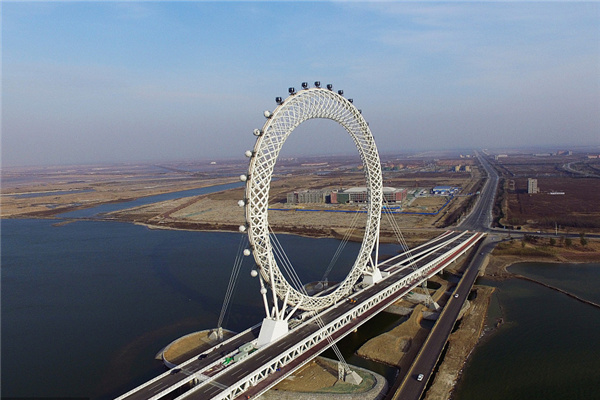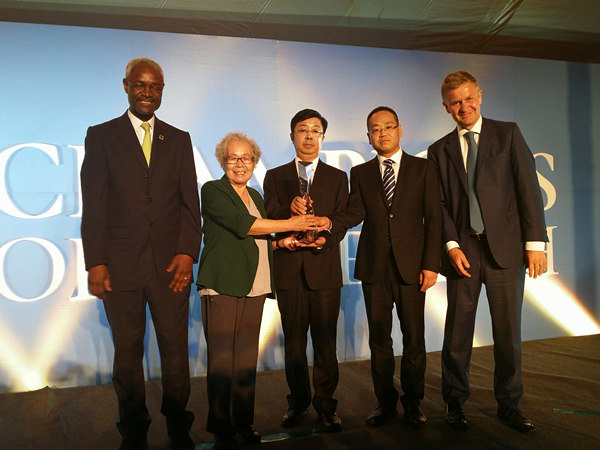

|
A made-in-Sweden ethonal-powered bus in Beijing. The environmentally-friendly bus could meet Euro-IV emission standards and reduce greenhouse gas emissions. CFP |
On Jan 8, 100 hybrid buses were put on the road in Wuhan, capital city of Hubei province, unveiling a large-scale project of promoting clean-energy vehicles in major cities in China.
The Ministry of Science and Technology (MOST) is promoting a project to put 5,000 hybrid buses, 20,000 hybrid taxis and 5,000 electric vehicles on the streets in 30 cities by 2012, hoping the trial run will increase the market share of clean-energy vehicles in the country.
The first batch of Chinese cities chosen for the project include Dalian, Shanghai, Wuhan, Shenzhen, Chongqing, Changsha, with Beijing, Tianjin and Hangzhou as the immediate candidates.
It is estimated that the project would save as much as 780 million liters of gasoline and diesel oil and avoid the emission of 2.3 million tons of carbon dioxide, according to MOST.
But this is only an example of a green trend emerging in the country: building low-carbon cities, as Wu Changhua, Greater China director of the London-based Climate Group, has witnessed.
"As a path for development, the core aim of a low-carbon economy is to increase energy efficiency and change the structure of energy consumption," said Wu.
Promoting clean-energy vehicles, together with other low-carbon technologies, shows that some cities have already taking leadership roles in the low-carbon initiatives, according to Wu.
A report released by the Climate Group shows that low-carbon economy is already taking shape in several Chinese cities, which include both metropolitan areas such as Beijing, and second or third tier cities, such as Wuxi from Jiangsu province and Dezhou from Shandong province.
Depending on green technologies, such as LED (Light-Emitting Diode) lighting system, building integrated photovoltaic, wind power and geothermal energy, these cities are embracing economic development with less greenhouse gas emissions.
With more than half of the world's population living in urban areas, cities contribute to 75 percent of the total global greenhouse gas emissions. As a result, making cities greener becomes more crucial in the fight against global warming.
The low-carbon city initiative is especially important to China, Wu pointed out, as the country is still halfway towards industrialization and urbanization.
The scale and pace of China's urbanization is expected to continue. The number of cities in China increased from 193 in 1978 to the current 667.
In the last decade, about 16 million people moved from the countryside to the urban areas every year, with urban residents totaling 594 million in 2007. It is estimated that China's urban population will hit one billion in 2025.
So setting up models of low-carbon cities will provide references for promoting the idea in China, said Zhuang Guiyang, a researcher with Chinese Academy of Social Science.
"Currently, there is no mature model of a developing low-carbon economy in the world, but this also provides China an opportunity to take the lead," Zhuang said.
The Climate Group's case studies for 12 Chinese cities show that policy incentives, large-scale technology application, financing mechanism and multi-stakeholders' cooperation are the four bases for developing a low-carbon city in China.
Cities with different population sizes also exemplify different models, the report said.
For instance, mega cities such as Beijing and Shanghai have made extensive explorations in adopting state-of-the-art technologies, taking advantages of their positions as host cities to global events.
Besides showcasing green technologies such as LED lighting and geothermal heating systems at the Olympic venues, Beijing also adopted transportation strategies to confront climate change and reduce air pollution from vehicle emissions.
Shanghai, in a similar move, has also outlined plans to ensure an environmentally friendly World Expo 2010. The city's ambitions even include building the world's first carbon-neutral city on its Chongming Island.
But experiences from smaller cities, such as Wuxi, could be more enlightening as their examples are easier to follow.
Wuxi in Jiangsu province, where most of China's leading solar energy companies cluster, has become China's largest production base of photovoltaic panels and related products.
In 2007, the output value of the city's photovoltaic industry reached 12.3 billion yuan, taking up 70 percent of the country's total. The export volume totaled $1.47 billion.
In Wuxi's case, investment in low-carbon technologies has become a new highlight of the city's economic growth, thanks to the government's vision for future.
"When starting his company, Shi Zhengrong, CEO of Suntech Power Holdings Ltd, had been turned down many times elsewhere, before he finally received support from Wuxi government," said Wu.
There are also cities, without much background of green industries hoping to integrate the low-carbon concept into their development and urban planning.
Guiyang, capital city of Guizhou province, has worked out a cooperation framework with the Climate Group, aiming to carry out five LED energy-saving programs in the city, according to Wang Chengbo, director of The Climate Group's Chinese City Leadership Program.
Wang said the Climate Group is seeking partnership among Chinese cities, aiming to foster about 20 low-carbon cities in China within three to five years.
It will urge the local governments and financial enterprises to help drive technology innovation and capital circulation through incentive policies and financial support, as well as promote low-carbon technologies for energy saving and emission reduction in these cities.
"It is a perfect time for promoting low-carbon cities in China right now," Wu said. Local governments in China are trying to find new highlights of economic growth, in a bid to update the industrial structure.
"China would miss the best opportunity to retain its technology advantage and core competitiveness in the world market if it lets slip the opportunities," Wu said.
(China Daily 02/09/2009 page5)













